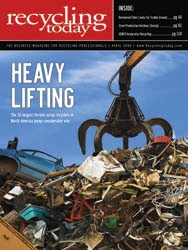A GLIMMER OF HOPE?
Is the beating that the nonferrous market has taken throughout the past several months coming to an end? Have markets stabilized enough? Have overseas buyers decided to come back into the market enough to help push demand?
In a nutshell, no one knows. Few analysts are willing to go too far out on a limb to say that the worst is behind us. However, we could be seeing the proverbial light at the end of the tunnel. Whether it is a pinprick of light or something much stronger remains to be seen, although in such a challenging environment any optimism is welcome.
Aluminum markets had been sluggish long before the downdraft in the global economy late last year. And, with the slide during the last quarter of 2008 and the first quarter of this year, aluminum seemed to take an even greater pounding.
By the middle of March, perhaps surprisingly, aluminum markets began to show signs of improving. This was despite reports indicating that aluminum inventory levels were climbing. One report from Reuters notes that in early March London Metal Exchange (LME) warehouses received 80,000 metric tons of aluminum in one day.
Several other sources say that while the environment for aluminum remains bleak, as a commodity, aluminum’s outlook is brighter. One industry watcher went so far as to say that the metal could bottom out in the next few months.
This somewhat bullish sentiment still runs into the reality that, globally, aluminum producers continue to slash production without yet finding a bottom.
Production cuts worldwide total around 6.5 million metric tons, representing nearly a 20 percent reduction from production figures last year. Despite this substantial cut, prevailing opinion assumes that further production reductions are likely.
Additionally, Alcoa and Alcan have slashed their dividends to save money. And Aleris, one of the largest consumers of secondary aluminum in the United States, has filed for bankruptcy protection. Auto production, a large end market for aluminum, is down sharply. The construction market, also a key consumer of aluminum, has been in a disaster zone for quite a while and isn’t likely to show signs of a turnaround.
Copper markets, while far from recovered, are improving. China has been restocking, which has helped to reduce global inventories of the metal. As a result, LME warehouses are seeing a decline in stocks, according to reports.
The Chinese government also has been buying copper, which has worked to give some footing to the copper market. According to one report, China’s Strategic Reserve Bureau has taken perhaps more than 400,000 metric tons of copper for inventory purposes.
However, while these purchases have worked to lessen stocks at LME warehouses, some analysts express concern that the purchases are just shifting inventories from LME to Chinese warehouses, where the buyers have taken advantage of lower prices without a commensurate increase in demand for production purposes.
And while this buying has helped boost prices, if China decides that it has enough inventory or the price creeps up too high, it could scale back copper purchases, eroding some of the price increases seen earlier in the year.
With the crash in copper prices at the end of last year, many scrap processors are seeing far less copper scrap coming across their scales, which is keeping markets slightly tighter than they were earlier this year.
Remarkably, copper has been on somewhat of a rebound, with copper prices up nearly 15 percent during the first three months of the year.
Of the other nonferrous metals, nickel, a prime ingredient in stainless steel, while down, seems to have more upside potential. A main reason has been the relative dearth of supply of the metal on the market, which should keep prices more stable to a degree.
(Additional news about nonferrous scrap, including breaking news, is available at www.RecyclingToday.com.)

Explore the April 2009 Issue
Check out more from this issue and find your next story to read.
Latest from Recycling Today
- Aqua Metals secures $1.5M loan, reports operational strides
- AF&PA urges veto of NY bill
- Aluminum Association includes recycling among 2025 policy priorities
- AISI applauds waterways spending bill
- Lux Research questions hydrogen’s transportation role
- Sonoco selling thermoformed, flexible packaging business to Toppan for $1.8B
- ReMA offers Superfund informational reports
- Hyster-Yale commits to US production





